Introduction
You enter a world where freedom is nothing more than a distant memory and oppression rules the land. The Regime, a powerful government, controls every aspect of citizens’ lives, dividing them into two distinct factions based on their abilities and interests. Play as the main character, a member of either faction and embark on a journey to overthrow the Regime and establish a new, more equitable society.
As you navigate the dangerous and unpredictable world of a dystopian future, you will be faced with challenges and obstacles at every turn. You must use your wit and ingenuity to gather information, plan daring operations, and lead a full-scale revolution against the all-powerful Regime. But be warned, not everyone can be trusted, and just when you think you have everything under control, everything can change in an instant.
Can you endure the tests of this oppressive world and emerge victorious, bringing freedom and equality to the citizens? Play now and find out!
Overview
The game is a decision-based game set in a dystopian world, where players assume the role of the main character who must navigate a dangerous and oppressive world controlled by a powerful Regime. Players have the option of choosing to play as a member of the marginalized faction of Poora or the privileged faction of Omega, each with distinct abilities and interests. Throughout the game, players will be faced with challenges and obstacles that will test their wit and cunning. They must also be careful not to trust everyone they encounter, as betrayal can come from unexpected places. As players progress through the game, they will have the opportunity to reflect on the unjustness in the world and the disparities that many people face. Overall, the game offers players an exciting and thought-provoking experience, as they navigate a dangerous and unpredictable world, and work towards establishing a more equitable society.
Initial Concept Map
The initial concept map of this decision-based game was crafted with pen and paper, mapping out the key storylines and establishing various branches that the player could take based on their decisions throughout the game. The game’s setting is a dystopian future where a powerful government, known as the Regime, controls every aspect of citizens’ lives. The society is divided into two distinct factions: the impoverished Poora and the wealthy Omega. The player’s character choice determines the environment they will mainly be in throughout the story.
The concept map was designed to offer players a sense of agency and choice as they navigate this dangerous world, with the opportunity to lead a full-scale revolution and create a more equitable society. Drawing inspiration from popular dystopian novels like the Hunger Games trilogy and Divergent, the game aims to challenge players to reflect on privilege and social inequalities.

Premise
The world of this decision-based game is set in a dystopian future that has fallen into chaos and inequality. The story is set in a fictional place known as the Regime, a land divided into two factions, the impoverished Poora and the wealthy Omega. Players take on the role of the main character, choosing between being a member of the Poora or the Omega. The journey players take is one of uncovering the truth behind the dystopian world, how it came to be, and what can be done to change it.
As players navigate the dangerous and unpredictable world of the Regime, they will face challenges, obstacles, and difficult decisions that will test their morality and values. They will gather information, plan daring operations, and lead a full-scale revolution against the all-powerful Regime. The plot unfolds through a series of branching storylines that depend on the decisions players make.
Ultimately, players will arrive at an understanding of the injustices and disparities in the world, and how privilege and power can lead to oppression and suffering. Through their journey, players will be persuaded to understand the importance of fighting against inequality, standing up for what is right, and working towards creating a more equitable society for all.
Learning Goals
Overall, The Rebellion has the potential to be an engaging and thought-provoking experience that encourages players to reflect on their privilege and consider ways to dismantle oppressive systems. The main learning goals of the game are as follows:
- Understanding the impact of privilege: By playing as characters from both factions, players can experience firsthand the privileges and disadvantages each group faces. This can help players understand the real-world disparities that exist and reflect on their own privilege.
- Recognizing systemic oppression: The game’s premise highlights a dystopian world where the Regime controls every aspect of citizens’ lives. By experiencing this world, players can gain a better understanding of how systems of oppression can be used to maintain power and control.
- Examining the role of power: The game’s storyline revolves around overthrowing the Regime and establishing a more equitable society. By exploring the dynamics of power and control, players can learn about the importance of dismantling unjust systems and redistributing power.
- Encouraging critical thinking: The game’s decision-based gameplay encourages players to think critically about their choices and the potential consequences. By reflecting on their decisions, players can develop critical thinking skills that can be applied to real-world situations.
- Promoting empathy: By playing as characters from different factions, players can develop empathy for others who may face different challenges and obstacles in life. This can help promote greater understanding and compassion for others.
Playtesting & Iterations
Playtest 1
During my playtest with Charlotte and Ecy, I received valuable feedback on my game. While they enjoyed the premise of the game and the ability to choose between two different perspectives, they recommended that I add more detail to the storyline. They felt that the narrative was quite short and could benefit from additional depth and complexity. Additionally, they suggested that I reinforce the narrative based on the decisions the player makes in the interactive fiction, making the consequences of those decisions more apparent. Furthermore, they suggested that I build more of a backstory for the main character to create a deeper connection between the player and the character they are controlling.
Despite these areas for improvement, Charlotte (M.S. in Computer Science) and Ecy (B.S. in Symbolic Systems) enjoyed the game’s ability to be played multiple times, offering a different experience with each playthrough. This feature allows the player to explore all possible outcomes of their decisions and encourages replayability.
Moving forward, I plan to focus on building out the story and developing the main character further. I will incorporate Charlotte and Ecy’s feedback and suggestions to create a more immersive and engaging experience for players. By adding more detail and depth to the narrative and providing consequences for player decisions, I hope to create a more thought-provoking game that highlights the injustices and disparities present in our world today.

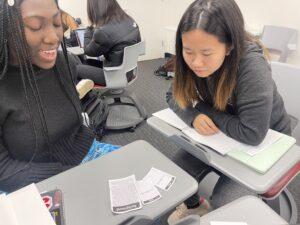
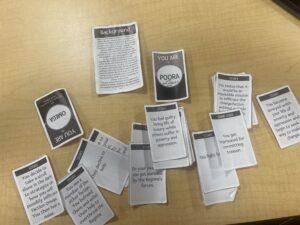
Playtest 2
In the second playtest with Marielle (M.A. in Education), several changes were made to the game based on the feedback received. The story was built out to include more descriptions of different passages, and additional background information was provided on the protagonist. Despite these improvements, some feedback still suggested the need for more choices and alternative endings. Participants recommended that players be allowed to choose non-conventional endings, such as giving up, and that two reasonably balanced and risky choices should be presented, with one potentially working and the other not. Furthermore, participants suggested adding more choices to the game to increase the player’s agency in the story. The feedback also emphasized the importance of allowing players to lose, with the aim of encouraging them to think creatively about how to reach the desired outcome.
Despite the areas for improvement, the second playtest also highlighted several things that were done well in the game. The story was found to be captivating and engaging, with different components connecting well with each other. Additionally, feedback suggested that the story was easily understood and not overly complex.
To further improve the game, there are several areas for improvement that should be considered. Participants recommended transitioning the game from a physical card-based format to a digital one, as it can be difficult to order the sequence of events with cards. Additionally, more interesting choices for players that deviate from a conventional storyline should be introduced. By incorporating these suggestions, the game can continue to evolve and improve in future iterations.

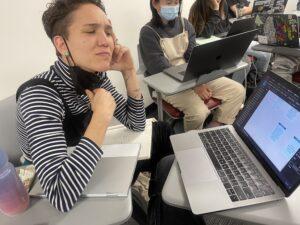
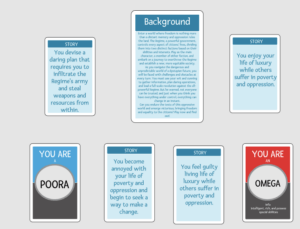
Playtest 3
Roxane (B.A. in Education) provided some valuable feedback in the final playtest. They suggested maintaining parallel structure and improving the wording in some of the screen options. They also recommended adding color to the different endings to associate them with the outcome, such as green for positive endings and red for negative ones. Roxane expressed feeling fully immersed in the game and enjoyed the well-written stories. However, they found some panels to be quite dense in text, making it hard to follow the story.
Overall, the digital format was well received, and players found the storytelling to be captivating. The game’s replayability was also appreciated, as it could have several endings based on the choices made throughout the game. Participants also enjoyed reading the game out loud, which further immersed them in the story.
Based on feedback from the final playtest, there are still some areas that could be improved upon. Adding images to the game could help to drive the narrative forward and make the story even more engaging. Additionally, breaking down some of the denser passages of text into multiple screens could make them easier to follow and keep players more engaged. These improvements could help to enhance the overall playability of the game and provide an even more immersive experience.
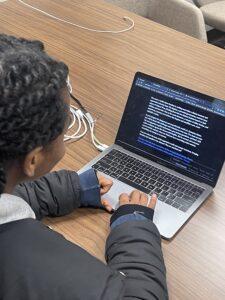
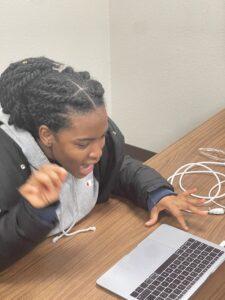
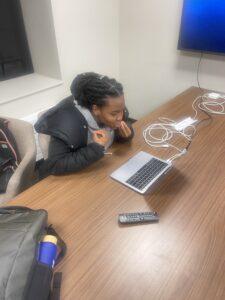
Reflection
One of the biggest lessons I learned was the importance of providing balanced choices. I had to create choices that were both appealing and challenging to players. If a choice was too easy, then the player might feel unchallenged or uninterested in the outcome. Conversely, if a choice was too difficult, the player might feel frustrated or hopeless. Therefore, I had to ensure that each choice was well thought out and balanced, with its own set of pros and cons.
Another important aspect was creating a backstory for my protagonist. The backstory was important because it helped the player understand the character’s motivations and actions. It also allowed the player to empathize with the character and feel more connected to the story. I learned that I needed to be careful in how I portrayed certain groups in the story. I did not want to feed into stereotypes or unintentionally offend anyone. Therefore, I had to be mindful of my language and depiction of different factions in the game.
Lastly, I faced a challenge in embedding images into the interactive fiction game. While I experimented with different methods, I ultimately decided to forgo images in my final iteration due to difficulties. However, I recognized that adding pictures could drive the narrative forward and make the game more engaging for players. If I were to do this again, I would allocate more time to experiment with embedding images into the game by soliciting the help of someone knowledgeable with the platform
Overall, creating this interactive fiction game was a rewarding experience that challenged me to think creatively and empathetically. I learned the importance of providing balanced choices, creating backstories, and being mindful of my language and depiction of different groups. I am excited to continue exploring the world of interactive fiction and see how I can continue to push the boundaries of a decision-based storytelling game.


